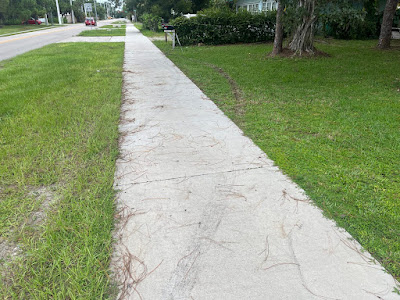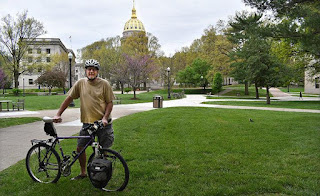As I've mentioned in other posts, for several years running, Florida is the US state where a cyclist is in the most danger of being killed by a motorist. No other state comes close in that category.
Of course, that doesn't mean the Sunshine State has a monopoly on intoxicated or distracted drivers, supersized diesel-powered pickup trucks with bodies customized to take up an entire roadway, drag racers (though the state is home to Daytona) or inherently dangerous roads.
As for the last item on that list: The single most dangerous road (excluding Interstates and other highways where bicycles are prohibited) for cyclists in the United States is in my home state of New York. In fact, it's in my backyard.
All right, since I'm an apartment dweller, I don't have a backyard. What I mean is that said thoroughfare is near me. In fact, I've crossed, though not ridden, on it a number of times.
According to the Nassau County and Hempstead Police Departments, drivers struck 320 cyclists and pedestrians on the 16 mile-long Hempstead Turnpike (a.k.a. New York State Route 24) between 2011 and 2021. Mind you, that is only the number of such incidents the constables know about through 911 calls. Of said victims, 13 died. Another six were killed just during the past year. The road is so dangerous for cyclists and pedestrians, in fact, that most of the fatalities were cyclists or pedestrians trying to cross the road so they could continue along one of the many streets that intersect with it.
The most impatient and hot-tempered drivers I've ever encountered, anywhere were along that road. When the light turns green, it's like a dam opening: a torrent of vehicles rushes through. Woe be to a cyclist or pedestrian, even one in a wheelchair, who happens to be in the path of that storm surge.
OK, so I mixed my metaphors a bit. But I think you have at least a partial picture of what I'm talking about. The drivers are indeed in a hurry to get to the store or through the next red light, but if someone wanted to design a traffic conduit that would bring out the worst in such drivers, he or she could hardly come up something that better fits the purpose than the Hempstead Turnpike.
 |
| Photo by Levi Mandel |
One problem is that, in some stretches, it's even wider than an Interstate (like an Autobahn or Autoroute). Through most of its length, it has eight lanes of traffic, with dividers that are low to the ground or nothing more than lines painted on the asphalt. Also in keeping with the worst in highway design, it has no bike or pedestrian lane or, for most of its length, sidewalks.
But unlike superhighways, it's not elevated or in a trench: It's at the same level as other streets. And, as it passes through residential and suburban residential neighborhoods, many two-lane and one-way streets cross it. That means many people must cross in order to get to work or school or go home.
What exacerbates all of these deficiencies is that the Hempstead Turnpike begins in an area of southeastern Queens that has one of the highest population densities in the United States but almost no mass transportation. That means people are car-dependent. That part of Queens is also relatively low-income and has few stores besides bodegas and small grocery stores. Thus, residents of that area frequently drive to the Nassau section of the highway, with its abundant stores (including supermarkets and chain stores), which offer more variety and lower prices.
Also, many residents work in those stores and in other area businesses. Meanwhile, the fact that on its Queens end, the highway connects with the Grand Central Parkway--a major artery to western Queens and Manhattan--also guarantees that many Nassau County residents drive their daily commutes on it.
When the Hempstead Turnpike isn't clogged with traffic--on most days, only from about 2 to 4 in the morning--it becomes our local version of Daytona. Sometimes the wannabe racers even test the limits of their machines, in speed and maneuverability, when there's traffic. The worst part is that they're not the only ones exceeding the 30- to- 40 mph speed limit. In fact, according to a grim joke or local folk wisdom (depending on whom you believe), police officers give tickets to drivers who don't speed because they're the ones the cops can catch .
Having crossed the Hempstead Turnpike many times, I'm not surprised to learn that it's officially the most dangerous road in this region, and probably the nation. Ironically, when I was "doored" nearly two years ago, I had just crossed the Hempstead Turnpike. It wouldn't surprise me if the driver who opened her door into my path--or the drivers who honked their horns out of frustration over having to stop for a cyclist lying in their path--had just turned off the Turnpike.















